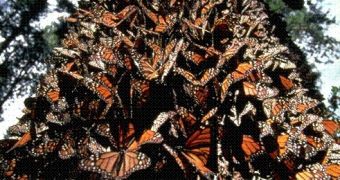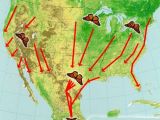Butterflies are renowned usually for their beauty. But amongst the 750 species of butterfly encountered in US and Canada, this is the most known worldwide, due to its amazing migration records. The black and orange beauty bears the name of monarch butterfly because the first English settlers of America associated it with their monarch Wilhelm of Orange. This royal insect weighs just 0.5 grams and has a wingspan of 8-10 cm (3.2-4 in), but still manages to make long, tiresome voyages.
This is the only butterfly to effectuate such long migrations and in such high numbers. During September, the monarch butterflies (Danaus plexipus) leave southern Canada and US locations to the wintering headquarters in California, Florida and Mexico, flying over 3,200 km (2,000 mi)! They cross large lakes, rivers, plains and mountains. Millions reach the peaks of the Sierra Madre Mountains of central Mexico.
This is even more amazing if we think that the young butterflies have never made the route, and have never seen the wintering places. Still, they fly with precision, knowing exactly when to stop.
Scientists can only suppose that the butterflies can read the angle of the solar rays, like the bees, or the geomagnetic field of the Earth, like migrating birds and bats. Perhaps the detection of temperature and humidity also helps.
The monarch butterflies can hover with 12 km (7.5 mi) per hour, fly upward with 18 km (11 mi) per hour and even have bursts of 35 km (22 mi) per hour. They are specialists in employing air currents, flying even against currents that usually blow from the west, to reach their destinations in the southwest. They can face currents varying in speed and direction and can use the thermal ascending currents for getting altitude.
The monarchs fly about 30 km (19 mi) per day and 3,000 km are made in about 130 days. The flight takes place only during daytime; during the night the butterflies rest, often exactly in the same place year after year.
Wing beats, hovering and thermal currents allow the butterflies to reach Mexico with enough fat for all the winter so that in spring (in March), they can fly back to the north.
It was known for long that monarch butterflies west of the Rocky Mountains wintered in California, hanging in clusters in pines and eucalyptuses. But the destination of the butterflies migrating from eastern Canada remained a mystery till 1976, when their secret hiding place was found: a forested peak in Sierra Madre, northwest of Mexico's capital. The branches and trunks of the oyamel fir trees, gray-greenish, were covered by millions and millions of butterflies (in total, about 100 million of butterflies). Even today, the view attracts many tourists.
In the National Park Point Pelee (Ontario, Canada), the butterflies can be seen gathering in clusters preparing for the migration, waiting on the northern edge of Lake Erie the favorable temperature and currents for starting the southward journey.
Researches revealed that monarchs migrating to Florida go through Caribbean islands to Yucatan peninsula and Guatemala. In all their wintering headquarters, the butterflies crowd on small patches of coniferous forests.
Do not think that the butterflies stay at warmth in their wintering places. The winter clime in Sierra Madre is cold, but it is exactly what these butterflies need: enough cold to be totally inactive, consuming little calories and prolonging their lives by 8-10 months, so that they can do the journey back.
When spring comes, the butterflies take sunbaths to warm their flight system, mate and head northwards. Some probably reach the places they left in autumn, but in most of the cases, only their descendants arrive like in the mountains of southeast Canada and northwest US. Gradually, 3-4 generations of butterflies, which went through the stages of egg, caterpillar, pupa and adult, cross the continent.
The female lays about 100 eggs on extremely toxic plants growing on pastures, like rattlepods (Crotalaria), heliotrope (Heliotropium) and spurges (Euphorbia) (which secrets a poisonous milk). The caterpillar is not only unharmed by the toxins, but accumulates them and transmits them into the adult stage, so that both caterpillar and adult are venomous. The adults feed exclusively on nectar and increase their weight six times before making the migration.
A Mexican mouse, Peromyscus melanotis, feeds during winter only on monarch butterflies. It effectuates migrations to the wintering areas of the butterflies and consumes mostly butterflies' inner tissues, which are less toxic.
But the main menace in the Mexican reserves made for protecting the monarch butterflies is the soil erosion and the illegal cutting of the oyamel fir trees (employed in timber industry). This led to a drop in the monarchs' number in the area by 70 %. While for some locals tourism is a source of income, others load during the night trucks with tree trunks belonging to this protected species. This can lead to the extinction of an entire race of monarch butterflies.

 14 DAY TRIAL //
14 DAY TRIAL // 
